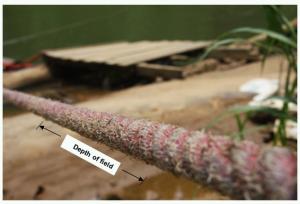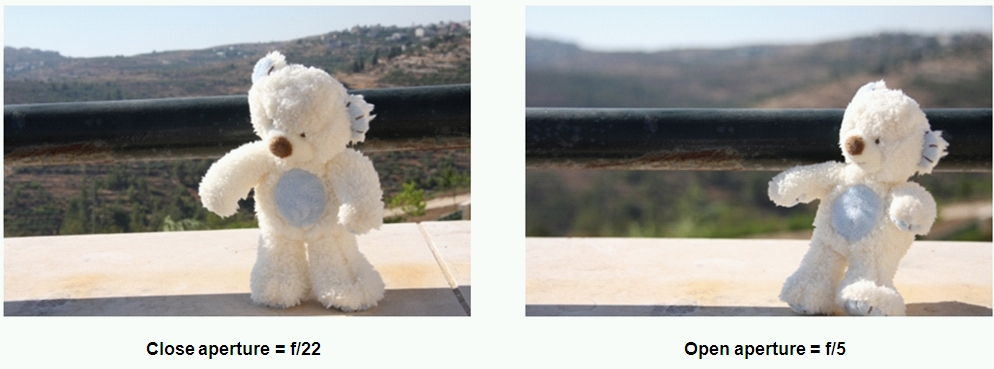Master depth of field and learn how to separate the wheat from the chaff
In photography, depth of field is the parameter that lets you determine what you want to be showcased front and center (even if it’s at the perimeter of the frame), and what should blend in with the background. Depth of field lets you take landscape photos that display the distant mountain as well as the boat sailing close by, or take a portrait that highlights every line in a man’s face, but leaves the lake in the background seeming like an indistinct blue object.

How can you set the depth of field and determine what will be in focus and what will be out of focus
Depth of field is determined by the aperture and the length of the lens. The larger the aperture, the more light enters the lens, and the smaller the depth of field (i.e. less objects in the photo will be in focus). Similarly, when using a long lens the depth of field is smaller, so if you want to photograph a person where his background and foreground come out blurry, you should use a long lens and keep the aperture wide open. If, on the other hand, you want to take a landscape shot where all the details come out sharp, you should use a wide angle lens and a relatively small aperture.

The photo above demonstrates that the area that comes out of focus depends on the aperture you use. The actual area where the depth of field occurs is determined in a less linear manner and depends on your position relative to the objects, and the central spot you chose to focus on. More on this later.

In the right photo (above), using a large aperture gives us the ability to only focus on the teddy bear and the rail it’s leaning on. In the left photo, the small aperture leads to a wide (or deep) depth of field where details in the background are also sharp.
The real focal point and its influence on sharpness
Important – either with manual or automatic focusing, you decide what spot to focus on. All other objects on the same plane (same distance from you) will come out sharp as well. If you choose a wide depth of field, objects in front and behind of that point will come out sharp.
Depth of field is not symmetrical – it usually spans from a third of the distance between you and the object, and two-thirds behind the object (this applies in most cases). So if you take the following example and choose to focus on the middle teddy (the fourth one), the third teddy will also be sharp, as will the fifth and the sixth teddies. Therefore, when you choose the object you will focus on remember that the depth of field around it is asymmetrical. If this doesn’t serve your goals, choose a different spot to focus on even if it’s not at the center of the frame or the path.

Common scenarios and their respective depth of field
The best way to decide on depth of field is to answer what are the important ingredients in your photo, and whether you want to differentiate the prominence of each of those ingredients.
For example: if you are photographing your husband while on vacation, you might want to use a narrow (shallow) depth of field that will highlight him and keep the background hazy. For that effect, you will use a relatively large aperture and probably a longer lens to capture his features, which will create a narrow depth of field. This is a common technique for portraits. There could be incidents, however, where you would want to see the background clearly.
In landscape photography, it is common to use a wide depth of field to capture all the details of the scenery. Landscape photography, goes naturally together with a wide-angle lens and a relatively small aperture, which create a wide depth of field. There are always exceptions, and you might want to take a landscape shot where you do focus on one thing in particular and go for a narrow depth of field.

In the left photo (above) we chose a narrow depth of field and focused on the part of the hammock that’s closest to us. Despite the ‘rules’ of photography, the main objects here (the father and his daughter) our outside the depth of field and are blurry. Don’t forget that breaking the rules can sometimes produce more interesting photos.
Automatic depth of field
Some of the more advanced cameras (especially the newer DSLR ones) have an ‘automatic depth of field’ feature. This feature finds all the objects in the frame and makes sure they all come out sharp.
Compact cameras are different, however. They do not have any advanced depth of field features, and they usually come with wide-angle lenses and a small aperture as a default. This creates a wide depth of field and makes most of the objects in the photo sharp.
The physical limitations of compact cameras, as well as the assumption that an untrained photographer will prefer a wide depth of field, means that most compact cameras produce a wide depth of field.
Compact cameras are different, however. They do not have any advanced depth of field features, and they usually come with wide-angle lenses and a small aperture as a default. This creates a wide depth of field and makes most of the objects in the photo sharp.
The physical limitations of compact cameras, as well as the assumption that an untrained photographer will prefer a wide depth of field, means that most compact cameras produce a wide depth of field.